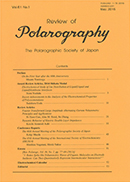巻号一覧

61 巻 (2015)
- 3 号 p. 173-
- 2 号 p. 75-
- 1 号 p. 1-
前身誌
61 巻, 1 号
選択された号の論文の9件中1~9を表示しています
- |<
- <
- 1
- >
- >|
巻頭言
-
冨永 昌人2015 年61 巻1 号 p. 1-2
発行日: 2015/05/13
公開日: 2015/06/12
ジャーナル フリーPDF形式でダウンロード (464K)
2014 志方メダル 記念総説
-
吉田 裕美2015 年61 巻1 号 p. 3-10
発行日: 2015/05/13
公開日: 2015/06/12
ジャーナル フリーThe distribution of ions at the liquid|liquid interface is the principle reaction of analytical methods for the determination and separation of ions such as ion-pair extraction and ion-selective electrodes. To elucidate the ion-distribution mechanism at the liquid|liquid interface, ion-transfer voltammetry with the liquid|liquid interface was employed, by which the transfer of a single ion at the liquid|liquid interface could be observed. This article reviews our studies on ion distribution at the liquid|liquid and liquid|membrane interfaces involved in analytical methods such as ion-pair extraction, ion-selective electrodes and electrolytic ion-extraction.抄録全体を表示PDF形式でダウンロード (793K) -
Ueda Tadaharu2015 年61 巻1 号 p. 11-19
発行日: 2015/05/13
公開日: 2015/06/12
ジャーナル フリーPolyoxometalates (POMs) have been studied for ca. 200 years since the first report on the synthesis of (NH4)3PMo12O40 in 1826. Even now, novel POMs are still being prepared, characterized and applied to various fields. Multi-step, multi-electron transfers reversibly occur for many redox active POMs, which is interesting to many electrochemists. Recently, the electrocatalytic behaviour of POMs has been focussed on due to the potential as a solution for energy problems. However, unclear aspects remain in terms of the fundamental electrochemical properties of POMs. This article reviews recent achievements on the electrochemistry of POMs in the solution phase.抄録全体を表示PDF形式でダウンロード (2316K)
総説
-
Si-Xuan Guo, Alan M. Bond, Jie Zhang2015 年61 巻1 号 p. 21-32
発行日: 2015/05/13
公開日: 2015/06/12
ジャーナル フリーIn this review article, the basic principles of Fourier transformed large amplitude ac voltammetry (FTACV), as developed by the Monash Electrochemistry Group, are surveyed. Special attention is paid to the key features associated with the higher order harmonic components of FTACV that are not available in dc transient voltammetry, including (1) enhanced kinetic sensitivity; (2) rejection of background charging current and (3) insensitivity to homogenous catalysis coupled to electron transfer. Examples are then given to demonstrate the high sensitivity offered by FTACV in studies of surface-confined processes and electrode kinetic determinations, and the ability to extract thermodynamic information relevant to the electron transfer step and kinetic data for the coupled catalytic process separately under catalytic turnover conditions.抄録全体を表示PDF形式でダウンロード (1698K) -
青木 幸一2015 年61 巻1 号 p. 33-42
発行日: 2015/05/13
公開日: 2015/06/12
ジャーナル フリーElectric double layer capacitance has the time-dependence with the power law of the ac-frequency. The dependence gives rise to a resistance component at the interface when the impedance is measured dynamically. The interfacial resistance does not really exist but is inevitably involved in the measured current as a result of the time-dependent capacitance. It is infinite for dc-response, but decreases with an increase in the ac-frequency in the inversely proportional form. It cannot be discriminated against the heterogeneous kinetics. The frequency-dependence agrees with the behavior of the constant phase element. The capacitance is brought about by orientation of solvent molecules, independent of concentration of salts, kinds of salts, and applied dc-potential. The orientation is modeled by combination of the external electric field and the interaction of nearest neighboring solvent molecules. Since the former conflicts with the latter in the orientation, phases may be formed two-dimensionally with competition, which prolong the relaxation with the lower law.抄録全体を表示PDF形式でダウンロード (712K)
学会リポート
-
前田 耕治2015 年61 巻1 号 p. 43-45
発行日: 2015/05/13
公開日: 2015/06/12
ジャーナル フリーPDF形式でダウンロード (1082K) -
永谷 広久, 坂江 広基2015 年61 巻1 号 p. 46-50
発行日: 2015/05/13
公開日: 2015/06/12
ジャーナル フリーPDF形式でダウンロード (1093K)
訂正記事
-
相樂 隆正2015 年61 巻1 号 p. 51
発行日: 2015/05/13
公開日: 2015/06/12
ジャーナル フリー誤植訂正のお知らせ
59巻, 2号, pp.77~89 (2013)
原著「3. 吸着有機分子の酸化還元が与えるスパイク波: 波形は分子間相互作用を定量的に反映するか?」(著者:相樂 隆正)において2個所訂正がありましたのでお知らせいたします。
1.本文 p.78 右カラム 式(3)の分母の引数中の RT/nF は分母子が逆です。
詳細は、本文PDFをご覧ください。
2.本文 p.83 左カラム 12 行目の「= instability ergion」の記載は、「= instability region」の誤りにつき,訂正いたします。抄録全体を表示PDF形式でダウンロード (145K)
編集後記
-
大堺 利行2015 年61 巻1 号 p. 53
発行日: 2015/05/13
公開日: 2015/06/12
ジャーナル フリーPDF形式でダウンロード (383K)
- |<
- <
- 1
- >
- >|